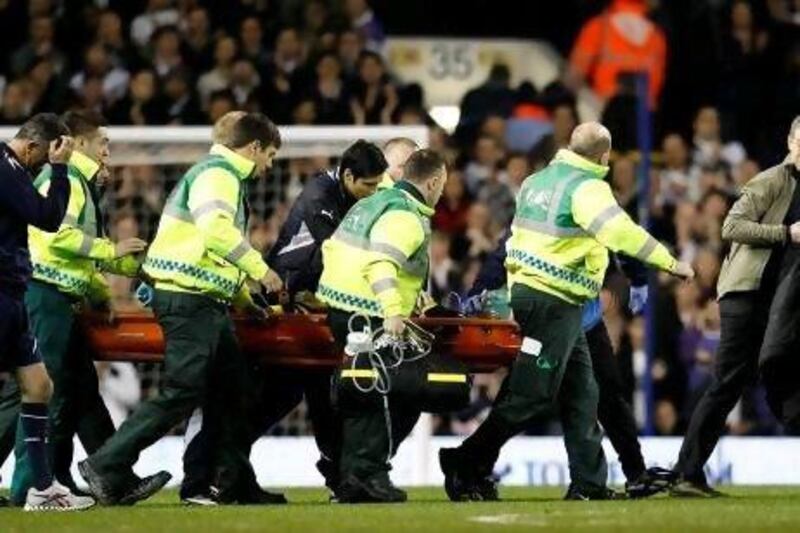The parallels are striking. Two Premier League footballers. Elite athletes in their primes. No one around them. They fall on their faces near the middle of the pitch. They do not rise.
Manchester City's Marc-Vivien Foe, in 2003. Bolton Wanderers' Fabrice Muamba in 2012. One significant and hopeful difference: Muamba clung to life yesterday. Foe was declared dead in the medical centre at the Stade de Gerland in Lyon, even as a Confederations Cup semi-final between his native Cameroon and Colombia continued.
Death is all around us. It is a condition of life. But the collapse of someone as young and fit as Muamba, a 23-year-old midfielder, shocks us on a fundamental level.
Heart attacks are what befall the elderly and unfit. Video of the match at White Hart Lane showed many fans weeping or in distress, horror writ large on their faces.
Like Muamba, Foe suffered a heart attack. His was brought on by a congenital condition identified as hypertrophic cardiomyopathy - the same diagnosis that in 2005 ended the career of Andy Scott, a former Sheffield United player in England.
The list of footballers who died suddenly, in this century, from heart failure is an appallingly lengthy one, and includes Phil O'Donnell, who played for the Scottish clubs Celtic and Motherwell, and two prominent Spanish players, Antonio Puerta of Sevilla and Daniel Jarque of Espanyol.
Many lists of the fallen do not include the name of Salem Saad, a UAE international, who collapsed and died at an Al Nasr training session in 2009.
Certainly, football makes extreme demands on the cardiovascular system. Perhaps some fatalities cannot be prevented. We suspect that some could.
In the NBA, five players since 2005 have undergone heart surgery to correct congenital heart defects. Each surgery was prompted by results found during echocardiograms, a non-invasive procedure now mandatory in pre-season medicals given to all NBA players.
Three of those five players returned to basketball, and two, Ronny Turiaf and Etan Thomas, are still in the NBA. A fourth, Jeff Green of the Boston Celtics is recovering and is expected to return.
Only last week, Chris Wilcox, also of the Celtics, was found to have an enlarged aorta; he too will have heart surgery.
In each case, regular and extensive testing identified the threat, perhaps preventing several sudden deaths in crowded arenas.
The English Premier League apparently requires twice-yearly heart checks. However, it is not clear whether a full battery of tests is conducted.
Also, Uefa calls for all first-team players of clubs that compete in international competitions to have the results of "at least one" electrocardiogram and echocardiogram in their medical files. Annual tests apparently are not required.
Among the young, sudden death from heart failure is most common in athletes. After Jarque's death, in 2009, the head of the European Society of Sports Cardiology told CNN: "Only 20 per cent of cases exhibit symptoms; for the other 80 per cent the first symptom is death."
The fallen players, and their loved ones, are those who suffer most from undetected cardiac conditions. The collateral damage is, however, extensive.
Study those faces in the stand at White Hart Lane, and you see the shock and pain. Fans came to see the joy and exuberance of skilled athletes. Instead, they left shaken and bewildered as a young man clinging to life was carried off the pitch on a stretcher.
In 2003, I hardly knew who Marc-Vivien Foe was. He had not played in Cameroon's scoreless Confederations Cup group match with the United States on June 23; his side had already clinched a berth in the semi-finals.
June 26 was a hot day in Lyon. Pius Ndiefi seized a 1-0 lead for Cameroon in the ninth minute, and Foe was booked in the 23rd. In the 72nd minute, he went to ground in the centre circle. The official Fifa match report shows a substitute coming on for him in the 75th minute. Those of us in the stadium remember being sick to our stomachs.
I remember almost nothing of that tournament - except the death before my eyes of Marc-Vivien Foe.
We can hope Muamba makes a full recovery, but the horror of seeing him limp on the grass will linger with the 36,000 who were at White Hart Lane on Saturday.
Even if Muamba's heart attack cannot be traced to a pre-existing condition, it is clear that top-flight football around the world needs to conduct thorough cardiac testing for players on an annual basis. For the sake of players stalked by silent killers. But also for fans who must live with the memory of an elite athlete lying helpless on the turf.
[ poberjuerge@thenational.ae ]
Follow us
[ @SprtNationalUAE ]
& Paul Oberjuerge
[ @PaulOberjuerge ]





